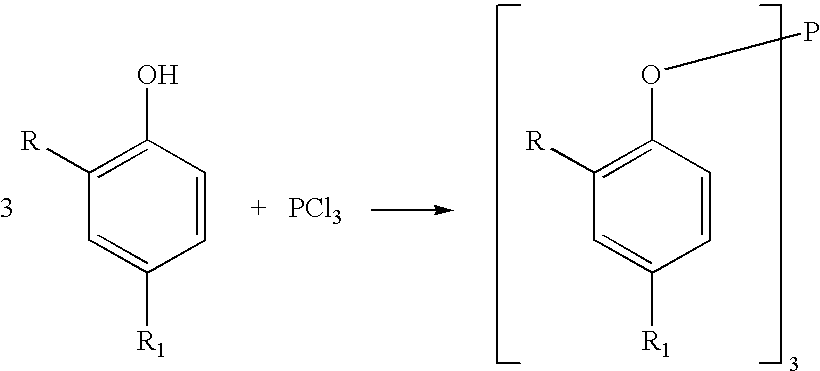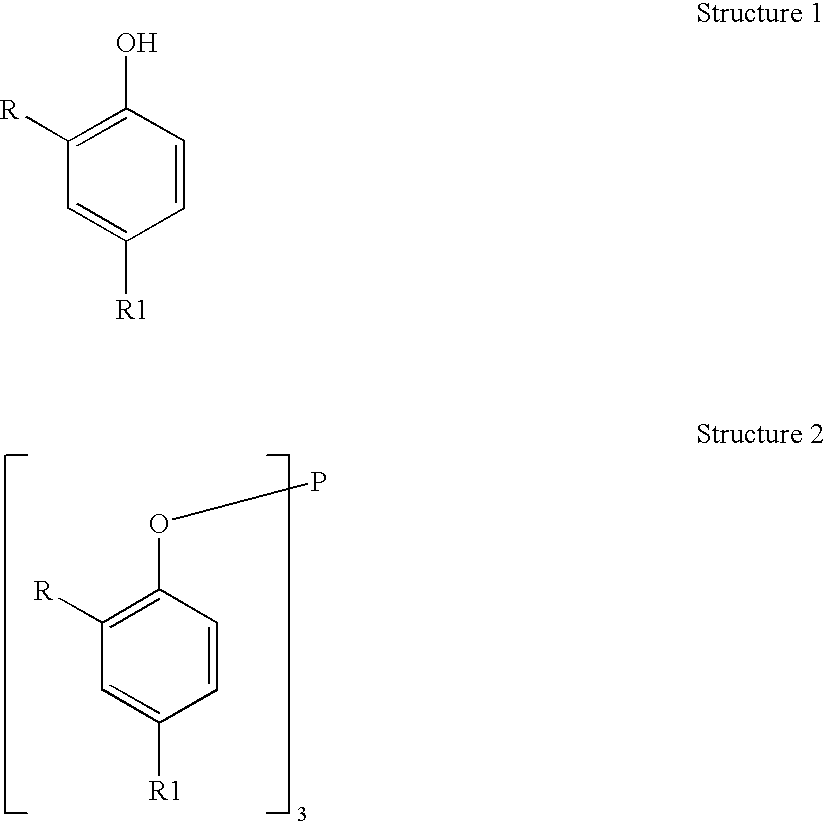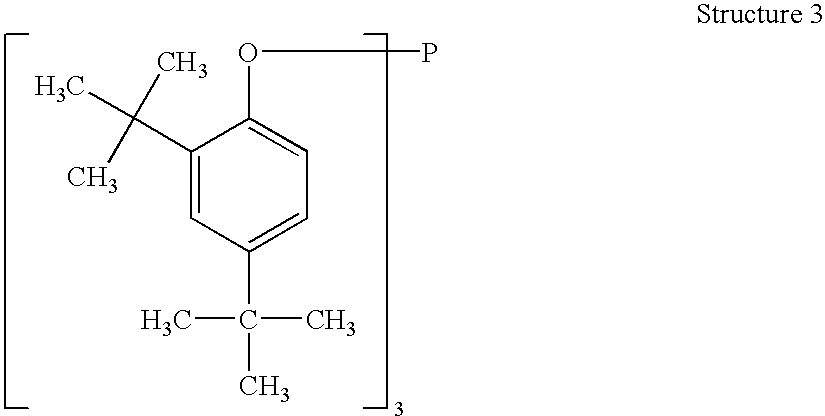Processes for producing triaryl phospite
a technology of triaryl phospite and phospite, which is applied in the field of triaryl phospite production processes, can solve the problems of hindering aryl phosphites, difficult preparation of ortho tertiary alkyl aryl phosphites, and inability to obtain acceptable yields of good quality, and achieves high yields and quality products.
- Summary
- Abstract
- Description
- Claims
- Application Information
AI Technical Summary
Benefits of technology
Problems solved by technology
Method used
Image
Examples
example 2
Preparation of tris (2,4-di tertiary amyl phenyl )phosphite
[0037] A 500 mL 3-necked flask equipped with a thermometer, an addition funnel, and a nitrogen / vacuum inlet attached to a Schlenk line manifold, was charged with 70.2 g (0.3 mole) of 2,4-ditertiary amyl phenol (Chemicals Unlimited, Mumbai, India), 23.7 g (0.3 mole) of pyridine in 200 ml methylene dichloride. 13.75 g (0.1 mole) of PCl.sub.3 was then added drop-wise at a temperature of 0 to 5.degree. C. under nitrogen atmosphere a period of 30 - 40 minutes. After the addition, the addition funnel was replaced with a distillation apparatus, and methylene chloride was distilled out at 40.degree. C. After addition of 100 ml isopropanol to the residue, the resultant white crystalline precipitate was then filtered and washed with cold methanol several times. The product weighed 68.6 g (94% of the theoretical yield). Material showed HPLC purity of 99.99% and melted at 106-108.degree. C. (lit value: 108.degree. C.).
example 3
Preparation of tris (2-tertiary butyl-4-methyl phenyl) phosphite
[0038] A 500 mL 3-necked flask equipped with a thermometer, an addition funnel, and a nitrogen / vacuum inlet attached to a Schlenk line manifold, was charged with 49.2 g (0.3 mole) of 2-tertiary butyl-4-methyl phenol, 23.7 g (0.3 mole) of pyridine in 200 ml methylene dichloride. 13.75 g (0.1 mole) of PCl.sub.3 was then added drop-wise at a temperature of 0 to 5.degree. C. under nitrogen atmosphere over a period of 30 to 40 minutes. After the addition, the addition funnel was replaced with a distillation apparatus, and methylene chloride was distilled out at 40.degree. C. After addition of 100 ml isopropanol to the residue, the resultant white crystalline precipitate was then filtered and washed with cold methanol several times. The product weighed 48.8 g (94% of the theoretical yield). Material showed HPLC purity of 99.99% and melted at 114 - 115.degree. C.(lit value: 115.degree. C.).
example 4
Recycling of Solvents and Lewis Base
[0039] Several series of experiments are carried out to illustrate the excellent results observed when the solvent filtrate was subjected to recovery of pyridine and isopropanol.
[0040] The filtrate containing IPA and pyridine hydrochloride was subjected for distillation at 50.degree. C. under reduced pressure to recover 95% isopropanol. The residue obtained was stirred with sodium hydroxide flakes and then subjected to distillation to recover 95% of pyridine. Purity of the solvent and base was >99% by GC and excellent results were obtained after reuse.
PUM
 Login to View More
Login to View More Abstract
Description
Claims
Application Information
 Login to View More
Login to View More - R&D
- Intellectual Property
- Life Sciences
- Materials
- Tech Scout
- Unparalleled Data Quality
- Higher Quality Content
- 60% Fewer Hallucinations
Browse by: Latest US Patents, China's latest patents, Technical Efficacy Thesaurus, Application Domain, Technology Topic, Popular Technical Reports.
© 2025 PatSnap. All rights reserved.Legal|Privacy policy|Modern Slavery Act Transparency Statement|Sitemap|About US| Contact US: help@patsnap.com



